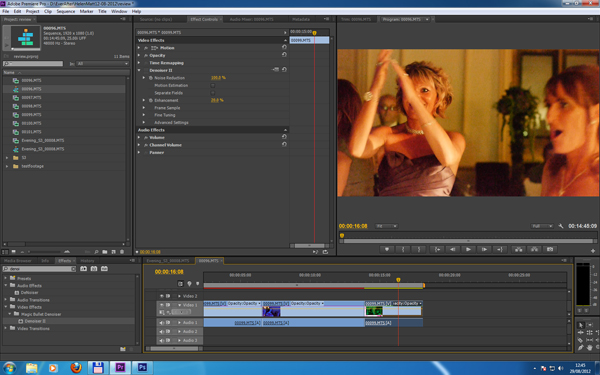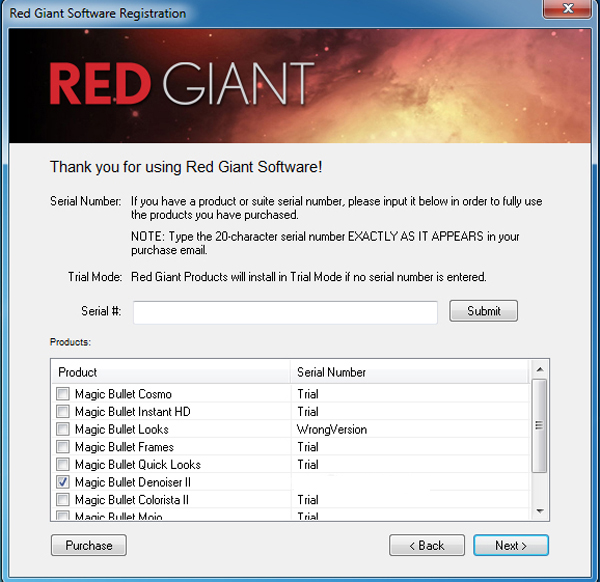Review: Magic Bullet Denoiser II
Magic Bullet Denoiser II is the latest version of Red Giant's popular plug-in for removing video noise from troublesome footage. Event and documentary filmmaker tests the plug-in on two different clips and shows before-and-after results and assesses Denoiser's usability, effectiveness, and rendering speed.
When I was asked to review the latest video plug-in release from Red Giant Software, I couldn't wait to get started. As an event videographer and documentary filmmaker, I can say with great confidence that Red Giant has made its mark on our industry. You would be hard pressed to find a single event videographer/editor who has not used or at least heard of their Magic Bullet Looks. Granted, this piece of software did result in a barrage of faked DOF and clips with an inconsistent heavily graded look, but in the hands of a professional, it is a great tool.
The plug-in I received for review is Denoiser II ($99). I tested it on a few of our systems, but the main system used was a 6-core AMD system with Nvidia Cuda card and a raid storage array running Adobe Premiere Pro CS5.5 and CS6.
What Denoiser Does: Video Noise Removal
Denoiser II, as the name suggests, tries to remove or minimize video noise you might have on your footage. The necessity of a professional tool to remove video noise in post presumes that lots of pros are still capturing noisy video. In a market where DSLRs with massive, light-sensitive sensors are very much the default choice, and prime lenses down to a mouth-watering f/0.95 are widely available, one might wonder exactly what problem this filter is trying to solve.
Let's be honest: However clever a piece of software might be, nothing beats getting the shot right in the first place. If you can add light or adjust your aperture to deal to compensate for a low-light situation, this should be a first port of call. However, even the best-laid plans can fail; adding light might not be an option, and a focus field the size of a needle tip is not necessarily a look one wants.
I'm sure many run-and-gun producers have come across footage that looks just a bit too noisy to use, but includes pivotal shots that are essential to their film. This is where Denoiser II comes (or at least tries to come) to the rescue. I used the plug-in in both Premiere Pro CS5.5 and CS6, not expecting different end results, but maybe a different render time. I shot a bit of footage specifically to test the software and also fed it some really noisy, hectic dance footage. Let's face it: We can usually light an interview the way we want, but if we're shooting weddings, spontaneous shenanigans on the dancefloor are a different matter.
All the footage captured for this test consisted of AVCHD MTS files as shot by a Panasonic GH2. I didn't use the famous hack to increase the bitrate, but did use it to remove the ISO limit in video mode. Instead of a limited ISO 3200, I could now feed the plug-in a whopping and very noisy ISO 12800 (Figure 1, below)!

Figure 1. A shot from a test clip shot at a very noisy ISO 12800
Installing Denoiser II
Let's start at the beginning: the installer. Red Giant has recently changed and unified their installers. Instead of an installer of every single product they own, and that's quite a list these days, all the installers are merged into 1. Run the installer (which comes in 32- and 64-bit flavors) and you're presented with some checkboxes that allow you to select the products you want to install. By default, these are all trial version applications; entering the serial number(s) for the product(s) you own will change that product into the full version (Figure 2, below). You can then select which products you want to install: the ones you bought and/or any trials you might be interested in. Although rolling all the installers into 1 program does make this download and system footprint a bit bigger, at today's typical internet speeds and hard drive sizes, it shouldn't be an issue. Personally, I like this idea and hope other companies might follow suit.

Figure 2. Installer options
The installer correctly identified all the compatible programs (and different versions thereof) on my system and, with easy checkboxes, I was able to choose to which ones I wanted to add Denoiser II. The process was painless and fast, and it proceeded without issues. It sounds silly to mention this, but I've come across too many installers that mess things up.
Before I go into specifics, it's important to realize that this type of plug-in always comes with a trade off. If you're expecting a magic wand that will clean up your footage, making it perfectly sharp, in focus, and looking like you shot it at ISO100, you will be disappointed. However clever the mathematics behind such a plug-in are, you should typically expect the sharpness of your image to degrade in favor of losing some of that ugly video noise.
Related Articles
A look at Magic Bullet's Denoiser III video noise reduction plug-in
In this tutorial, Jan Ozer demonstrates how you can use the Neat Video plug-in to remove noise from video, improving output quality for all outputs.